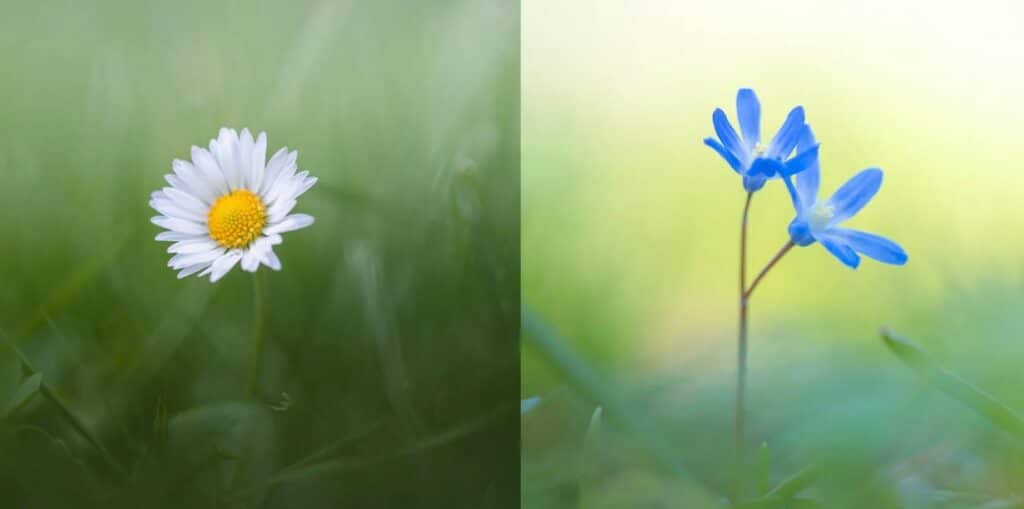Macro photography is best for capturing flowers’ complex beauty. The best tips for macro flower photography may make your floral photos look like art. Macro flower photography brings you a world of creativity and beauty for amateurs and pros alike. Start with gear. Invest in a macro lens for stunning close-ups. You may focus on minute details to see petals and stamens’ rich patterns and textures using its specialised optics.
When shooting in low light, a tripod provides steadiness. After gathering the gear, let’s discuss some practical advice. Lighting is a top tips for macro flower photography. Flowers look best in soft, diffused natural light without strong shadows. Shoot outdoors on overcast days or at dawn and dusk for soft light. A diffuser can soften harsh sunlight. Composition is important in macro photography.
Try different angles and viewpoints to get appealing photographs. Take close-up photos of the exquisite features or stand back to photograph the blossom against a hazy background. Finally, be creative with post-processing. Changes to contrast, saturation, and sharpness may make macro flower photos stand out. Practice makes perfect, so keep trying new things to take great macro flower photos. These best tips for macro flower photography can help you capture nature’s beauty in amazing detail.
Read More: 10 Best Photography Blogs to Follow for Inspiration
List of 10 Best Tips for Macro Flower Photography
Use a focal point and aperture to blur the backdrop and highlight the bloom’s intricacies to take gorgeous macro flower photos. Try to catch natural light to avoid harsh shadows. Keep the camera steady or use a tripod for sharp photos. Use diverse angles and viewpoints to add depth and intrigue to your photos. Adjust the white balance to match the flower’s colours. Take time to discover the proper composition and wait for the right shot. Finally, enjoy macro flower photography’s subtle beauty and be creative.
Invest in a Quality Macro Lens

Starting to take macro flower shots requires a macro lens. This optical device connects your camera to flowers’ intriguing world, exposing their exquisite intricacies in amazing clarity. It’s important because it brings the camera near to the subject, capturing even the finest details with incredible clarity and realism. also Flower Macro Photography.
Dedicated macro lenses have features designed for macro photography. These features let you explore flowers in ways that ordinary lenses cannot. With a macro lens, you may easily discover the floral world’s hidden treasures.
Master Manual Focus

Flowers’ delicate features require careful Flower Macro Photography Tip. To make minute details like petal veins and stamen forms look sharp, precise focus is needed. Manual focus allows photographers to control their photographs like never before. Manual focus offers exact focus point modification in macro objects, unlike auto-focus systems.
This level of control lets photographers catch the exact details they want, creating breathtaking macro photos. Mastering manual focus is essential for macro photographers and can improve their photographs.
Use a Sturdy Tripod

Macro photography requires camera stability. The tiniest motion can distort your subject’s delicate features. For clear photos of tiny objects, a tripod is needed. A robust tripod keeps the camera still throughout key exposures.
Securely attaching your camera captures clear, accurate shots of minute textures and details. A sturdy tripod is a good investment for macro photographers. It stabilizes camera shake so you can focus on framing the photo. With a firm platform, macro photography can capture the world’s intricate details with precision and clarity.
Mind Your Depth of Field

One thing that makes Best macro photography stand out is its narrow depth of field, which gives the photos a unique and interesting look. In this type of photography, only a small part of the subject is clearly focused. Everything else around the subject fades into a soft, dreamy blur.
By playing around with different apertures, shooters can masterfully change the depth of field and get the most out of this style. A smaller f-number means the aperture is wider, which means the background blur is stronger. This effect is called bokeh.
Harness Natural Light

Natural light illuminates flower photographs best. Best Macro photographs in the golden hours—early mornings and late afternoons—are magical with it. Soft, diffused light gives your photos a dreamy look at these periods. Soft, slanting sunshine warms your images and highlights the flowers’ vivid colors and unique textures.
This gentle light reduces sharp shadows, illuminating subjects evenly and flatteringly. The natural beauty filter! Flowers seem prettier in natural light because you can see every petal and stamen detail. The next time you picture flowers, wait until the golden hours and let nature’s light work.
Experiment with Angles

Flowers are relaxing to photograph, and different angles may make them stand out. Best Flower Macro Photography Tip is about capturing their beauty in fascinating ways. To do this, think creatively and try new things. Photos from above show petals’ complex patterns and brilliant colors.
Our bird’s-eye view shows the flower’s structural beauty. investigate unexpected angles to create photographs that pique curiosity and inspire others to investigate botanical treasures. Let your creativity shine when you’re out with your camera and see flowers from a different perspective.
Pay Attention to Composition

Macro flower photography requires fundamental framing rules for appealing and balanced photos. These tips turn your images into masterpieces. One important element is the “rule of thirds,” which involves dividing the frame into nine equal portions and placing the subject along the gridlines or intersections.
This method adds mystery and highlights the image’s most important elements. Following this rule creates visually appealing photos that draw visitors in and convey artistry. This technique lets you find new angles and maximize your macro flower photography, turning commonplace scenes into stunning images.
Exercise Patience

The Best Macro photography requires patience. Patience and observation are needed to photograph nature’s complex features. These moments—watching a bee carefully pollinate a flower or a raindrop glitter on a petal—are fleeting. Waiting for the right moment lets you see nature’s dance and capture these fleeting moments in photos.
It takes time, but the rewards are great. By watching and waiting, you can learn about nature one frame at a time. Remember patience next time you’re out with your camera. Not simply taking images, but appreciating the revelation that develops with each moment.
Utilize a Remote Shutter Release

When photographing macro flowers, a remote shutter release or camera timer is essential. These small accessories help reduce camera shake, a typical problem when taking close-up photos. Using a remote release or timer keeps the camera stable for perfect photos.
Macro flower photography is complex and requires precision. Any minor movement could degrade image clarity and sharpness. Therefore, using a remote shutter release or timer assures that your macro flower photos are detailed and precise. These devices make photographing flowers easy and improves the quality of your images.
Embrace post-processing

Post-processing improves mini-flower photographs. Feel free to change color, contrast, and sharpness. These adjustments can bring your photos to life by boosting the contrast between light and dark areas, amplifying the flowers’ vibrant colors, and showing delicate features that may have been missed.
In post-production, you can turn your photos into stunning works of art. Explore multiple editing methods to acquire the desired impact and enjoy the creative process of enhancing your photographs. You can improve your mini-flower photography by experimenting and keeping an open mind to capture breathtaking images of nature’s beauty. also find best tip for Flower Macro Photography.
Verdict
The Art Photography Projects impact us beyond photography. They etched themselves in our thoughts. They demonstrate our strengths and shortcomings and the complexity of existence.
Start exploring macro flower photography to uncover a world of wonder and beauty. Flowers may be turned into art with the right techniques and an eye. Remember that this project is about communicating the feelings and tales hidden in those petals, not just capturing the image.
Read More: 10 Best Wildlife Photography Tips For Beginners
FAQs
Do I need an expensive camera to snap macro flowers?
While a high-quality camera will surely improve your outcomes, you need not require the most expensive equipment. Begin with what you have and gradually upgrade to specialised lenses and accessories as you improve your talents.
How close should I get for macro photography?
Macro photography frequently entails getting up close and personal with your subject. The exact distance depends on your lens, but being only a few inches away from the flower is fairly uncommon. Take care not to cast shadows or disrupt the scene.
Can I take macro photographs without a tripod?
While it is possible to do macro photography handheld, a tripod is strongly suggested for greater stability. It produces sharp photographs, particularly in low-light situations or while employing shorter shutter speeds.





